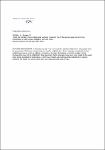Tools for cellular immunology and vaccine research the in the guinea pig: Monoclonal antibodies to cell surface antigens and cell lines
Schäfer, Hubert
Burger, Reinhard
The use of monoclonal antibodies directed against membrane proteins of leukocytes has greatly contributed to our understanding of the function and development of the immune system. Meanwhile these reagents provide valuable tools in many fields of research, stretching far beyond immunology and hematology. For guinea pigs only a limited number of such reagents have been described, and the information about availability and specificity is scattered over many years and journals. We provide an overview on the monoclonal antibodies produced since the technique was applied first in this species, with a focus on those reagents which have been characterized in more detail, and which should still be available either commercially or directly from the labs that created them.
Dateien zu dieser Publikation
Keine Lizenzangabe
Verwandte Publikationen
Anzeige der Publikationen mit ähnlichem Titel, Autor, Urheber und Thema.
-
2010-05-24ZeitschriftenartikelInducible costimulator (ICOS) blockade inhibits accumulation of polyfunctional T helper 1/T helper 17 cells and mitigates autoimmune arthritis Frey, Oliver; Meisel, Juliane; Hutloff, Andreas; Bonhagen, Kerstin; Bruns, Lisa; Kroczek, Richard; Morawietz, Lars; Kamradt, ThomasObjectives: Inducible costimulator (ICOS) and its ligand (ICOSL) regulate T and B cell responses. Glucose-6-phosphate isomerase (G6PI)-induced arthritis requires T and B lymphocytes. It was hypothesised that blocking ...
-
2016-02-26ZeitschriftenartikelLocal T/B cooperation in inflamed tissues is supported by T follicular helper-like cells Van, Dana Vu; Beier, Katja C.; Pietzke, Lea-Jean; Baz, Maysun S. Al; Feist, Randi K.; Gurka, Stephanie; Hamelmann, Eckard; Kroczek, Richard; Hutloff, AndreasAutoimmune diseases and other inflammatory conditions are characterized by large lymphocytic tissue infiltrates in which T and B cells can be found in close contact. Here, using a murine airway inflammation model, we compare ...
-
2013-04-15ZeitschriftenartikelGiardia duodenalis arginine deiminase modulates the phenotype and cytokine secretion of human dendritic cells by depletion of arginine and formation of ammonia Banik, Stefanie; Viveros, Pablo Renner; Seeber, Frank; Klotz, Christian; Ignatius, Ralf; Aebischer, ToniDepletion of arginine is a recognized strategy that pathogens use to evade immune effector mechanisms. Depletion depends on microbial enzymes such as arginases, which are considered virulence factors. The effect is mostly ...

